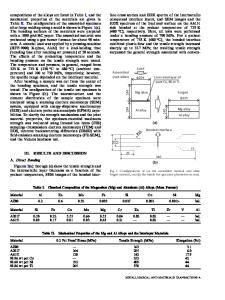Optimization of Friction-Stir Welding of 6061-T6 Aluminum Alloy
- PDF / 9,177,813 Bytes
- 28 Pages / 612 x 792 pts (letter) Page_size
- 75 Downloads / 319 Views
mization of Friction-Stir Welding of 6061-T6 Aluminum Alloy I. V. Vysotskiy1, S. S. Malopheyev1, S. Yu. Mironov1*, and R. O. Kaibyshev1 1
Belgorod National Research University, Belgorod, 308015 Russia * e-mail: [email protected]
Received November 12, 2019, revised November 12, 2019, accepted November 20, 2019
Abstract—In this work, two simple but effective strategies were proposed to optimize friction-stir welding of 6061-T6 aluminum alloy. The first one involved an optimization of welding variables to provide a combination of a relatively high welding temperature and the shortest possible thermal cycle during friction-stir welding. This inhibited precipitation coarsening in the heat-affected zone and resulted in considerable residual stress. Accordingly, the produced welds exhibited excellent strength characteristics under static and cyclic loading conditions. The second method was based on the application of the standard postweld T6 tempering. To avoid the abnormal grain growth, which usually occurs during solutionizing of aluminum frictionstir welds, a prestrain rolling was employed prior to the material tempering. This promoted an activation of recrystallization processes during subsequent heat treatment, thus suppressing the abnormal grain growth. Keywords: heat-treatable aluminum alloys, friction-stir welding (FSW), heat treatment, precipitation strengthening, abnormal grain growth, fatigue DOI: 10.1134/S1029959920050057
1. INTRODUCTION 1.1. Weldability of Heat-Treatable Aluminum Alloys Due to attractive combination of low density, good service properties and reasonably low cost, heat-treatable aluminum alloys are widely used in transportation industry. However, a significant problem of such materials is a relatively poor weldability by conventional fusion techniques. This necessitates using a riveting approach for manufacturing of large-scale aviation structures thus increasing their total weight and cost and degrading performance. In this regard, friction-stir welding (FSW), an innovative technology, is widely considered as a very promising candidate for joining of these alloys [1, 2]. Being a solid-state technique, friction-stir welding avoids (or minimizes) solidification problems associated with the fusion welding and therefore may produce high-quality welds with excellent mechanical characteristics. In aviation industry, friction-stir welding may replace riveting and thereby principally improve the manufacturing technology. Given industrial significance of friction-stir welding of heat-treatable aluminum alloys, significant efforts have been undertaken recently to explore the
fundamental aspects of this process and thus to efficiently control the weld properties. Some of the most important results are briefly summarized below. 1.2. Precipitation Phenomena Induced by Friction-Stir Welding Since the strength characteristics of the heat-treatable aluminum alloys are essentially contributed by nanoscale coherent precipitates, the particle behavior during friction-stir welding represents a particular int
Data Loading...











